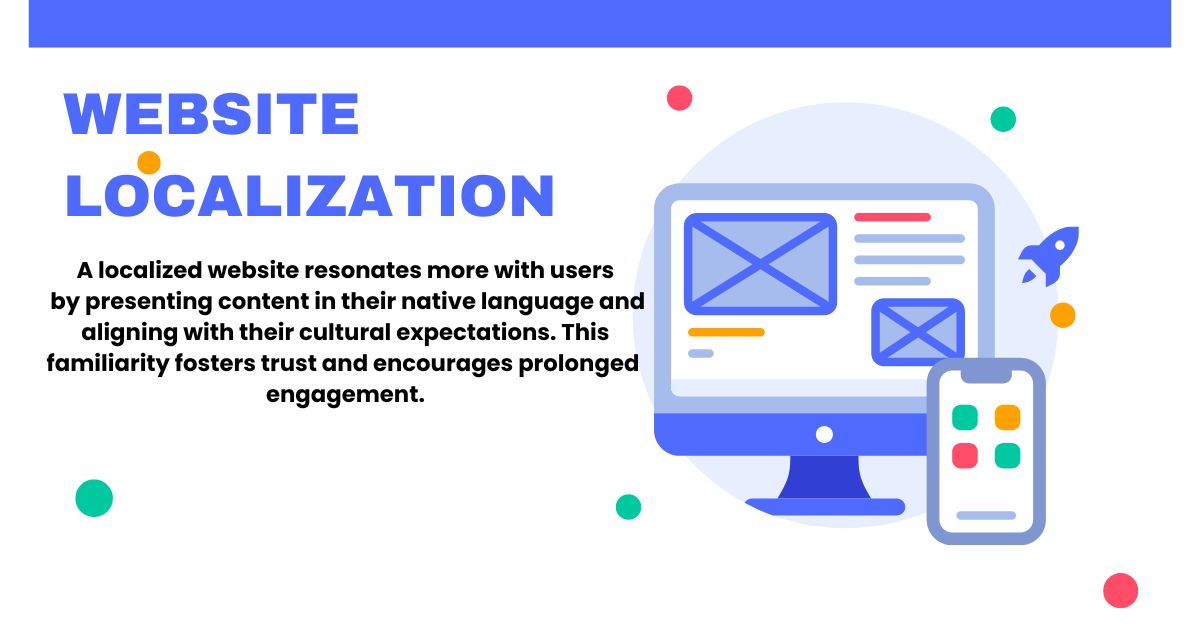
Website Localization
Website localization is the process of adapting a website’s content, design, and functionality to meet the cultural, linguistic, and technical requirements of a specific target market. Unlike mere translation, localization encompasses a comprehensive approach that considers local customs, user behavior, and legal regulations to provide a seamless user experience.
In today’s globalized digital landscape, businesses aiming to expand internationally must prioritize website localization to effectively engage diverse audiences and drive conversions.
Why Website Localization Matters
1. Enhances User Experience
A localized website resonates more with users by presenting content in their native language and aligning with their cultural expectations. This familiarity fosters trust and encourages prolonged engagement.
2. Increases Market Reach
By tailoring your website to different regions, you tap into new markets, reaching potential customers who prefer or require content in their native language.
3. Boosts Conversion Rates
Localized websites often see higher conversion rates as users are more likely to purchase products or services when information is presented in their language and cultural context.
4. Improves SEO Performance
Localization involves optimizing for local search engines and keywords, enhancing visibility in regional search results and driving organic traffic.
Key Elements of Website Localization
1. Language Translation
Accurate translation is foundational. However, it’s essential to go beyond literal translation to capture the nuances and idioms of the target language, ensuring the message resonates culturally.
2. Cultural Adaptation
This involves modifying content to align with local customs, values, and expectations. For instance, color schemes, imagery, and humor should be appropriate for the target culture.
3. Legal and Regulatory Compliance
Different countries have varying regulations regarding data privacy, consumer rights, and online transactions. Ensuring compliance is crucial to avoid legal issues.
4. Technical Adjustments
This includes adapting date formats, currency, measurement units, and ensuring the website supports right-to-left languages if necessary.
Read our latest our Local Market Research
Steps to Effectively Localize Your Website
1. Conduct Market Research
Understand the cultural, linguistic, and consumer behavior aspects of the target market. Identify local competitors and analyze their strategies.
2. Develop a Localization Strategy
Define the scope, budget, and timeline. Decide which parts of the website need localization and determine the resources required.
3. Assemble a Localization Team
Include translators, cultural consultants, developers, and SEO experts to ensure a comprehensive approach.
4. Implement Technical Infrastructure
Ensure your website’s backend supports multiple languages and regional settings. Use content management systems (CMS) that facilitate localization.
5. Translate and Adapt Content
Translate text accurately and adapt multimedia elements. Ensure that all content, including images and videos, aligns with cultural norms.
6. Optimize for Local SEO
Research local keywords, optimize meta tags, and create region-specific content to improve search engine rankings in the target market.
7. Test the Localized Website
Conduct thorough testing to identify and fix issues related to language display, functionality, and user experience.
8. Launch and Monitor
After launching, monitor user engagement, feedback, and performance metrics to make continuous improvements.
Best Practices for Website Localization
1. Use Professional Translators
Employ native speakers with expertise in the subject matter to ensure accurate and culturally appropriate translations.
2. Maintain Consistent Branding
While adapting content, ensure that the brand’s voice and identity remain consistent across all localized versions.
3. Leverage Localization Tools
Utilize translation management systems (TMS) and localization platforms to streamline the process and maintain quality.
4. Prioritize Mobile Optimization
Ensure that localized websites are responsive and provide a seamless experience across all devices.
5. Gather User Feedback
Encourage feedback from local users to identify areas for improvement and to better understand user preferences.
Common Challenges in Website Localization
1. Cultural Misinterpretations
Misunderstanding cultural nuances can lead to content that offends or alienates the target audience.
2. Technical Limitations
Inadequate infrastructure can hinder the implementation of localized features, affecting user experience.
3. Inconsistent Terminology
Without a standardized glossary, translations can become inconsistent, confusing users and diluting brand messaging.
4. SEO Complications
Incorrect implementation of hreflang tags or failure to optimize for local search engines can negatively impact visibility.
Conclusion
Website localization is a strategic investment that enables businesses to connect with global audiences effectively. By understanding and implementing the key aspects of localization—linguistic accuracy, cultural relevance, legal compliance, and technical adaptability—you can enhance user experience, expand market reach, and drive business growth.
Embracing website localization not only demonstrates respect for diverse cultures but also positions your brand as globally conscious and customer-centric.
Leave a Reply